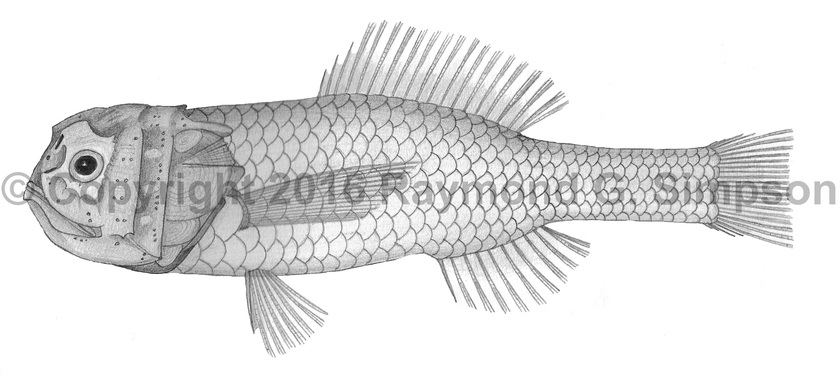
Common Name
Snub-nosed Bigscale
Year Described
Ebeling, 1962
Identification
Dorsal Fin: III, 15-17
Anal Fin: I, 8-9
Pectoral Fin: 14-16
Pelvic Fin: I, 7
Caudal Fin: 9-10 branched, 4 procurrent rays
Lateral Scale Rows: 32-36
Gill Rakers: 15-19
Vertebrae: 28-30
Head with numerous bony ridges and pits. No post-temporal spines, projecting anterior spines, or raised bony crest on top of head. Preopercle and opercle margins relatively smooth or with weak spination. Gill rakers in first arch relatively few (19 or less). Anal fin origin under last four rays of dorsal fin. Pectoral fin reaches last ray of dorsal fin. Pelvic fin origin slightly behind pectoral fin origin. Body scales large and easily shed. Four scales on gill cover. Two cheek scales.
Color
Body uniformly dark to black.
Size
Maximum size to 29mm SL
Habitat
Mesopelagic below 100m, with juveniles occurring closer to the surface.
Range
Northwestern Atlantic from the Grand Banks to the Caribbean Sea and Gulf of Mexico.
References
Ebeling, A. W. and W. H. Weed, III. 1973. Order Xenoberyces (Stephanoberyciformes). In: Fishes of the Western North Atlantic. Memoirs of the Sears Foundation of Marine Research Mem. 1 (pt 6): 397-478.
McEachran, J.D. and J.D. Fechhelm. 1998. Fishes of the Gulf of Mexico. Volume 1: Myxiniformes to Gasterosteiformes. University of Texas Press, Austin. i-viii + 1-1112.
Moore, J. A., K. E. Hartel, J. E. Craddock, and J. K. Galbraith. 2003. An annotated list of deepwater fishes from off the New England region, with new area records. Northeastern Naturalist 10(2): 159-248.
Other Notes
Melamphaes pumilus, M. simus, and M. typhlops are distinguished by their very low gill raker counts compared to the other oligo-rakered species in the region. Melamphaes pumilus has an intermediate dorsal, vertebral, and gill raker count in between M. simus (high end) and M. typhlops (low end).